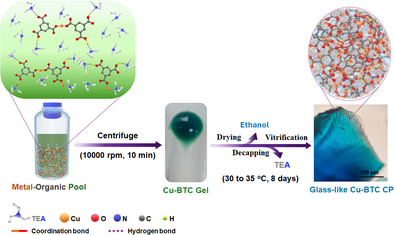A Capping-assisted Strategy for Synthesis of Glass-like Carboxylate-based Coordination Polymers
Graphical Abstract
Abstract
The direct preparation of glass-like carboxylate-based coordination polymers (CPs) possessing continuous internal structure and transparency is challenging due to the lack of control on coordination kinetics and subsequently the range of order. Herein, a capping-assisted strategy was presented to control the molecular assembly during the metal-ligand coordination in the solution and to inhibit the long-range of order hence building glass-like CPs (g-CPs) mimicking the polymerization process. 1,3,5-benzene tricarboxylate (BTC) ligand was used to connect the copper cations (Cu2+) into metal-organic complexes of different Cu: BTC ratios (metal-organic pool) in presence of an excess of triethyl amine as a capping agent. Concentrating the Cu-BTC complexes and further drying under mild conditions induced the decapping process which triggered the random crosslinking between the free carboxylate and Cu2+ to form a boundary-free continuous internal structure. The as-prepared Cu-BTC g-CP exhibited an approximately similar fine structure like its crystalline counterpart (HKUST-1), which facilitated solvent and thermal-induced crystallization. Due to the internal structure continuity, the g-CP possesses ceramic-like hardness and wear resistance and plastic-like resilience. This capping-assisted strategy has been successfully extended to Ni-BTC and Fe-BTC systems under mild conditions and thus presenting a general method for the formation of glass-like carboxylate-based CPs.
Conflict of Interests
The authors declare no conflict of interest.
Open Research
Data Availability Statement
The data that support the findings of this study are available in the Supporting Information of this article.





